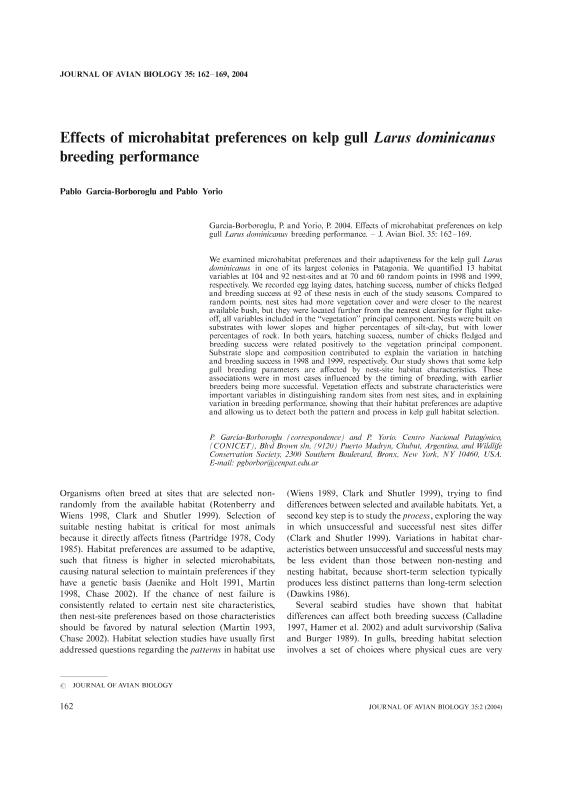Artículo
Effects of microhabitat preferences on kelp gull Larus dominicanus breeding performance
Fecha de publicación:
02/2004
Editorial:
Wiley Blackwell Publishing, Inc
Revista:
Journal Of Avian Biology
ISSN:
0908-8857
e-ISSN:
1600-048X
Idioma:
Inglés
Tipo de recurso:
Artículo publicado
Clasificación temática:
Resumen
We examined microhabitat preferences and their adaptiveness for the kelp gull Larus dominicanus in one of its largest colonies in Patagonia. We quantified 13 habitat variables at 104 and 92 nest-sites and at 70 and 60 random points in 1998 and 1999, respectively. We recorded egg laying dates, hatching success, number of chicks fledged and breeding success at 92 of these nests in each of the study seasons. Compared to random points, nest sites had more vegetation cover and were closer to the nearest available bush, but they were located further from the nearest clearing for flight takeoff, all variables included in the ‘‘vegetation’’ principal component. Nests were built on substrates with lower slopes and higher percentages of silt-clay, but with lower percentages of rock. In both years, hatching success, number of chicks fledged and breeding success were related positively to the vegetation principal component. Substrate slope and composition contributed to explain the variation in hatching and breeding success in 1998 and 1999, respectively. Our study shows that some kelp gull breeding parameters are affected by nest-site habitat characteristics. These associations were in most cases influenced by the timing of breeding, with earlier breeders being more successful. Vegetation effects and substrate characteristics were important variables in distinguishing random sites from nest sites, and in explaining variation in breeding performance, showing that their habitat preferences are adaptive and allowing us to detect both the pattern and process in kelp gull habitat selection.
Archivos asociados
Licencia
Identificadores
Colecciones
Articulos(CCT-CENPAT)
Articulos de CTRO.CIENTIFICO TECNOL.CONICET - CENPAT
Articulos de CTRO.CIENTIFICO TECNOL.CONICET - CENPAT
Citación
Garcia Borboroglu, Jorge Pablo; Yorio, Pablo Martin; Effects of microhabitat preferences on kelp gull Larus dominicanus breeding performance; Wiley Blackwell Publishing, Inc; Journal Of Avian Biology; 35; 2; 2-2004; 162-169
Compartir
Altmétricas




